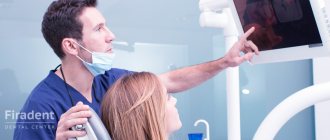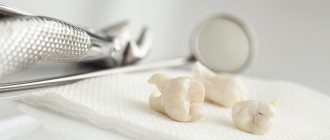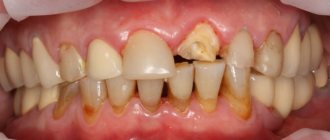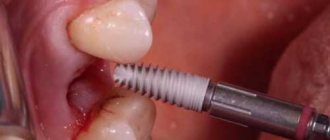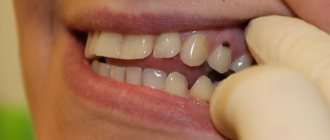What causes dental caries?
Caries is a progressive disease that destroys the hard tissues of the tooth. Cariogenic bacteria live in the oral cavity; they form a biological film on the surface of the teeth - dental plaque. They feed on carbohydrates that enter our bodies through food and drinks. Bacteria process sugars and produce organic acids. Those, in turn, corrode tooth enamel and deep tooth tissues. This is how caries develops.
In this article
- What causes dental caries?
- How does caries progress?
- A dangerous complication of caries is pulpitis.
- How is pulpitis treated?
- Periodontitis as a dangerous consequence of caries
- How is periodontitis treated?
- What is the danger of caries for the gastrointestinal tract?
- ENT diseases as consequences of caries
- Why is caries dangerous for the heart and blood vessels?
- Risk of death from dental caries
- Conclusion
Although bacteria living in the oral cavity play an important role in the development of carious lesions, a complex of unfavorable factors is important for tooth decay:
- an abundance of “fast” carbohydrates in the diet (sweets, flour);
- poor dental and oral hygiene;
- lack of calcium, fluorine, phosphorus, vitamin D in the body;
- weakened immunity.
Reason four: financial
In the initial stages, caries treatment is relatively inexpensive and absolutely affordable for everyone. However, with the development of complications up to the loss of a tooth, treatment becomes increasingly more expensive: treating pulpitis is already noticeably more expensive than caries, since the volume of manipulations and materials consumed are greater. As for the loss of a tooth that has not been treated in time, prosthetics will cost quite a hefty sum. Therefore, those people who do not care too much about their health may benefit from the financial argument.
How does caries progress?
There is a myth that caries is necessarily a hole in the tooth, but in reality, dental disease begins with the loss of mineral substances in the tooth enamel and gradually progresses. Caries goes through four stages in its development. Let's look at them below.
- Spot stage.
There is no hole in the tooth yet, but a whitish spot is noticeable on the surface. A change in the color and structure of the enamel means that it is losing minerals in this area. At an early stage there is no pain or discomfort, so patients rarely go to the dentist, not even suspecting the presence of caries. But it is at the spot stage that caries is easiest to cure. The progression of the disease can be stopped using conservative methods without drilling or installing a filling. At this stage, remineralization, simple and deep fluoridation, and the infiltration method are effective.
- Superficial caries.
At this stage of development of the disease, a small carious cavity forms within the enamel. The patient may have the first complaints: the tooth reacts to cold and hot, sour and sweet, food gets stuck in the resulting hole.
- Average caries.
The carious cavity becomes larger and affects the dentin - the bone tissue of the tooth under the enamel. At this stage, acute toothache most often appears; food stuck in the hole causes severe discomfort, and the patient complains to the dentist. It will not be possible to cure average caries without preparing the tooth, so an operative approach is used in treatment - using a drill, the affected tissue is removed and the cavity is filled with special composite materials.
- Deep caries.
The carious lesion affects the deepest layers of dentin and approaches the dental nerve. All the symptoms that were there before intensify, sometimes becoming chronic. Frequent complications of deep caries are pulpitis and periodontitis (inflammation of the pulp and tissues surrounding the tooth root).
It is better to treat caries in the early stages, while there is no carious cavity in the tooth. Conservative methods will help stop the pathological process without drilling and filling. If a hole has already formed in the tooth, then you cannot do without a drill. What if you don't treat it? Many people have been afraid of dentists since childhood and put off visiting the doctor as much as possible. This should not be done under any circumstances, because caries is dangerous for the body due to its consequences. With an advanced form of the disease, you can lose a tooth or develop purulent inflammation. There are even cases of death from complications of deep caries. Therefore, it is imperative to treat the disease!
Who will not benefit from anesthesia?
— How to relieve fear of the dental office?
— 80% of success in work depends on the professionalism of the dentist, 20% on the patient’s attitude towards treatment and his psychological comfort. I see my goal as removing all fears from patients. They need to explain in as much detail as possible what we will do and what it will look like - all the treatment tactics.
Families come to us, sometimes for decades. So we, one might say, become family doctors.
In addition, visiting the dentist is now much more convenient than before. For example, the patient does not need to sit in the corridor and wait for an X-ray image; everything comes immediately to the doctor’s computer.
Dental clinic No. 3.
Altapress.ru.
Dentistry is a field that is developing by leaps and bounds. Today, doctors sometimes have to redo work that someone else did 10-15 years ago. Because modern equipment and filling materials have appeared that provide a long-term guarantee of reliability.
Currently, all this is possible not only in commercial clinics, but also free of charge in the compulsory health insurance system.
— Basically, a person is afraid of pain. What innovations are there in terms of anesthesia?
“We are now working with modern drugs, they are effective and at the same time gentle. They can even be used when working with patients in the early stages of pregnancy.
Radmila Labyntseva.
Altapress.ru.
There are contraindications. For example, pain relief is not possible for people with cardiac arrhythmias. But even here the doctor can choose the most suitable drug. No one now endures pain in dentistry.
“People are also scared by the fact that anesthesia does not help everyone. What are the chances that pain relief will not occur?
— It depends on the individual characteristics of the organism. Most often, anesthesia does not help if a person takes certain medications. For example, a toothache, and the patient does not go to the doctor for two weeks and drinks painkillers in packs. Then the effectiveness of anesthesia decreases.
The same thing happens in advanced cases when there is a large inflammatory process.
Dental clinic No. 3.
Altapress.ru.
A dangerous complication of caries is pulpitis.
The most common consequence of untreated caries is pulpitis. It occurs when the infection extends beyond the tooth and spreads to the pulp - the neurovascular bundle, or dental nerve.
The pulp contains nerves and blood vessels and provides nutrition to the dental tissues. Therefore, with pulpitis, the tooth may lose vitality. In severe cases, inflammation spreads to neighboring tissues.
A characteristic symptom of pulpitis is acute, prolonged pain that is difficult to tolerate. It often has a pulsating nature and can radiate to the temple, ear, or throat. The peculiarity is that attacks of pain appear at certain intervals, last about 5 minutes, and can intensify when lying down. It is necessary to begin treatment of pulpitis as quickly as possible.
Signs of caries in children
After solving the question “does caries of baby teeth need to be treated,” a new one appears. Namely: how to understand that a child has caries?
The symptoms of dental diseases are simple:
- Complaints of pain - at night, during meals or during the day.
- The appearance of yellow or brown spots on the enamel of the teeth.
- Bad breath.
- Excessively careful chewing of food - with teeth on only one side.
Unfortunately, caries can occur without visible signs. For this reason, dentists advise periodically examining the child’s oral cavity and monitoring the quality of teeth cleaning.
How is pulpitis treated?
Pulpitis can be treated biologically or surgically. The first is applicable if the disease is in its early stages. The dentist strives to preserve the pulp by eliminating only the inflammation. If possible, pulpitis of primary teeth is treated using a biological method, when it is especially important to preserve the tooth root. Treatment is carried out in several stages. First, the dentist prepares the carious cavity, opening it as wide as possible. Then he treats it with an antiseptic, puts a swab with an antibacterial agent and covers the tooth with a bandage. During the next appointment, if the patient has no complaints, the cavity is treated with medication, filled with a special composition that stimulates dentin production, and a temporary filling is placed for a period of 5 to 7 days. During the third appointment, the dental crown is filled.
When the biological method of treating pulpitis is ineffective, surgical treatment is used. In this case, the inflamed neurovascular bundle is removed completely or partially. Without a nerve, a tooth becomes unviable and its service life is reduced.
Surgical treatment is performed with local anesthesia. First, the carious cavity is prepared, the pulp is removed, the affected area is treated with an antiseptic, medication is injected, and first the root canals are filled, and then the dental crown. As with the biological method, surgical treatment is carried out over several visits to the dentist.
If pulpitis is not treated, it will progress and can lead to very serious complications:
- flux - inflammatory process in the periosteum;
- periodontitis - inflammation of the tissues surrounding the tooth;
- pulp necrosis - death of its cells;
- sepsis is a blood infection that can develop when an infection enters the bloodstream.
You can avoid such complications if you do not delay your visit to the dentist and begin treatment for the disease at the first symptoms.
No tooth - no problem
“Often older people think: I only have three teeth left, okay, I won’t even brush them.” Is it necessary to undergo treatment in this case?
— The oral cavity is not sterile, it has a special microflora, so it is always necessary to take care of it. Even if there are no teeth, because the mucous membrane can also be injured and lead to more serious diseases.
Radmila Labyntseva.
Altapress.ru.
— It is believed that braces are a matter for children. Why does malocclusion occur in adulthood and how important is it to correct it?
— There are many reasons for malocclusion in adults. Most often these are consequences of dental development disorders in childhood. Mostly, malocclusion is diagnosed in people whose childhood was spent, again, in Soviet times.
At that time, the aesthetic component of treatment was relegated to the background; people were more concerned about health. Basically it was like this: the tooth got sick - it was removed. No tooth - no problem. If the parents had taken the child to the doctor in time, the malocclusion could have been corrected, the teeth could have been saved, and with them the health of the entire oral cavity.
In addition to external distortions, malocclusion can affect the quality of food digestion and even speech. This is also psychologically important, because a person with such a pathology is embarrassed not only to communicate, but also to open his mouth.
Dentist. Dental treatment.
CC0
Periodontitis as a dangerous consequence of caries
Against the background of untreated caries and dental pulpitis, the infection penetrates even deeper. As a result, periodontitis develops. This is a disease in which the tissue around the tooth root becomes inflamed - periodontium. Essentially, it is a ligamentous apparatus that holds the tooth in the jaw and provides shock absorption. With periodontitis, an abscess may form near the diseased tooth, and in this case, treatment will require opening the tooth and cutting the gum.
Periodontitis can occur in acute and chronic forms. Acute is characterized by a rapidly developing inflammatory process. The tooth darkens, becomes loose, the patient complains of acute pain, inflammation of the cheek may occur, and swelling appears in the area of the affected tissue. In a chronic course, pronounced symptoms may be absent, and pain occurs only during periods of exacerbation. Chronic periodontitis requires long-term complex therapy, which can take several months. The disease greatly weakens the immune defense and generally negatively affects the condition of the body.
Are complications possible after dental treatment, what could they be?
For some time after dental treatment, the patient may be bothered by a slight aching pain, which usually occurs during the process of chewing food. In this case, there is no need to sound the alarm, such pain is not a complication: it is observed after treatment of deep caries due to the pressure of the filling on the pulp and will go away in a few days without taking any medications, on its own.
But if the tooth hurts severely and the discomfort does not disappear after taking painkillers, you should go to the doctor urgently! This symptom indicates the preservation and continuation of the active development of the inflammatory process in the tooth. Usually the cause of such a complication is poor quality of primary dental treatment. At Uni Dent dentistry in St. Petersburg you can undergo dental treatment of any complexity.
Our clinic offers patients modern dental treatment methods, innovative equipment, sensitive and experienced staff, and doctors who regularly improve their qualifications abroad. Trust the health of your teeth to professionals - come to Uni Dent dentistry in St. Petersburg!
How is periodontitis treated?
The approach to treating periodontitis may vary depending on its type, severity, patient history and other factors.
The chronic form of the disease is treated according to the following scheme:
- The area of the diseased tooth is numbed with anesthetics.
- First, the affected tissue and old fillings are removed from the root canal, the tooth is depulped, and, if necessary, the root canal is expanded using dental drills or a microscopic incision.
- At the second stage, the root canal is cleaned and washed with antiseptic solutions. An antibacterial drug is placed into the canal cavity, which relieves the inflammatory process and fights infection.
- The tooth is covered with a temporary filling, and antibacterial and anti-inflammatory drugs are prescribed.
- The patient is sent home, where he must strictly follow all the dentist’s recommendations. The next appointment is usually scheduled after three or four days.
- At the second stage of treatment, a control photograph is taken. If the inflammation is stopped, the dentist removes the temporary filling and medicine from the root canals, rinses the cavities with an antiseptic, and fills the canals with a special composite material. It contains substances that help restore dental tissues and destroy pathogenic microorganisms. This filling of the canals is temporary and is needed in order to completely stop the inflammation and reduce the risk of re-developing periodontitis in the future. It is done for several months, and the tooth is again covered with a temporary filling.
- A few months later, the patient comes for a follow-up appointment with the dentist, where a tooth photograph is taken again to evaluate the effectiveness of the treatment. If the inflammation has completely stopped, the final stage of treatment begins - replacing temporary fillings with permanent ones and restoring the dental crown with a permanent light-curing filling. After this, the process of treating chronic periodontitis is considered complete.
- Unfortunately, it is not always possible to carry out conservative treatment of this disease. In advanced forms, the dentist is forced to resort to surgical treatment, when part of the root or the entire tooth is removed.
Treatment of periodontitis is long, complex and expensive, and the disease itself is a source of chronic infection, negatively affects the entire body, and weakens the immune system. It is easier and safer to contact the dentist on time and treat early caries. The consequences of an advanced disease are dangerous for the body.
How does pediatric dentistry work?
A pediatric dentist is a psychologist and pediatrician rolled into one. The specialist is obliged not only to fulfill direct professional duties, but also to find an approach to a small, most often frightened patient.
Adults know that treatment and removal of teeth is no longer a sophisticated torture, but a comfortable procedure. But it’s difficult to explain this to children, so parents should think about introducing their child to a dentist as early as possible. Start with consultation visits, help the doctor create a trusting relationship with the child.
If the situation is urgent, then you need to go to a clinic with trusted specialists who will treat children’s teeth efficiently, without pain and tears, and most importantly, quickly. By the way, specialists at the Doctor Martin clinic advise, if possible, not to give your child painkillers if pain in the teeth occurs, but to call the dentists and make an appointment or get a consultation.
Nowadays, children have access to a variety of services—preventive, therapeutic, and surgical. When visiting the dentist at least once every six months, there is a chance that the child will only get preventive care.
What is the danger of caries for the gastrointestinal tract?
Caries and its complications have a harmful effect not only on teeth, but also on other organs and systems of the body. In particular, diseases of the gastrointestinal tract - pancreatitis, gastritis, duodenal and stomach ulcers - often occur against the background of dental caries.
The fact is that with caries and any other dental diseases, pathogenic microflora is activated in the oral cavity. Together with food and saliva, it can easily penetrate the esophagus into the stomach and intestines, causing an inflammatory process. As microbes multiply, they crowd out beneficial microorganisms and lead to the development of gastrointestinal diseases. On the other hand, the state of the digestive organs directly depends on the quality of chewing food. Caries negatively affects this function, because with damaged chewing teeth a person cannot efficiently process food to such a state that the gastrointestinal tract can easily absorb and digest it. As a result, there is an excess load on the stomach, intestines, and duodenum, which leads to pathologies of the digestive organs. In addition, poorly chewed food makes it worse for nutrients to be absorbed.
Modern research shows that even deposits on healthy teeth can threaten the health of the stomach and intestines. Thus, the bacteria Helicobacter pylori accumulate in tartar, which contributes to the development of peptic ulcers. Therefore, not only timely treatment of caries, but also its prevention, in particular proper and regular oral hygiene, helps reduce the risk of gastrointestinal diseases.
The need for anesthesia before dental treatment
Anesthesia during dental treatment is not always necessary, but only in cases where the destruction has affected the deep layers of dentin. There are nerve endings in the deep layers of tooth tissue, and therefore any manipulation in this area can cause significant pain to the patient. To eliminate discomfort during dental treatment under such circumstances, anesthesia is administered before the start of the treatment process, selected individually. The anesthetic is administered by injection, but there is no need to be afraid of an injection: modern syringes have ultra-thin needles that allow you to administer the medicine quickly and painlessly.
For patients with a high pain threshold, anesthesia can be given not only before dental treatment, but also before such activities as professional cleaning of dental surfaces and whitening. Typically, topical anesthesia is chosen. General anesthesia is used in dental treatment
extremely rarely - mainly before complex and lengthy operations. It is worth knowing that general anesthesia has a number of contraindications and therefore, before choosing this anesthesia technique, the patient must undergo a series of tests.
Why is caries dangerous for the heart and blood vessels?
When brushing your teeth, there is a risk of injury to your gums. This can happen due to a brush that is too hard, careless use of dental floss, or sensitivity of the gums themselves. One way or another, cariogenic bacteria enter the resulting wounds, which can be carried throughout the body by the bloodstream. If they get into the tissue of the heart, inflammation of its valves may develop - infective endocarditis.
Studies show that with advanced caries, the risk of developing cardiovascular pathologies increases by 70%. When bacteria enter the blood, they settle on the vascular walls next to atherosclerotic plaques. As a result, the plaque begins to actively grow and can clog the vessel, disrupting normal blood flow. The most dangerous consequences can be thrombosis, stroke, heart attack, atherosclerosis.
How brushing your teeth makes life easier
Hygiene is another category of dental services around which panic can still be heard: “brushing your teeth spoils the enamel,” “you can damage your gums,” “it’s harmful.”
In fact, the greatest harm comes from plaque and mineralized deposits, which cause pigmentation and penetration of microorganisms deep into the enamel. As a result, teeth deteriorate, turn yellow and decay. To avoid this outcome, you need to remove plaque using professional equipment.
Typically, professional hygiene is carried out in three stages:
— removal of dental plaque with ultrasound;
— cleaning with Air Flow, which removes soft pigmented deposits;
- polishing with abrasive pastes, making the enamel surface smooth to “repel” plaque. Thus, the cleaning result lasts for a longer period.
It is recommended to carry out the procedure twice a year, after consulting with your dentist.
Risk of death from dental caries
Many people underestimate the danger of caries, considering this disease to be frivolous. However, there are known cases of death from complications of untreated caries. How is this possible?
For example, if the inflammatory process from the roots of the teeth of the upper jaw spreads to the maxillary sinuses, sinusitis may occur, which can spread greatly without treatment. When the infection extends beyond the jaws, there is a possibility of a brain abscess, purulent inflammation, sepsis - all these complications can be fatal.
Another danger is the so-called pathological fracture of the jaw. This condition is associated with a cyst in the jaw, which occurs as a complication of advanced caries.
All of these dangers are real and can occur against the background of dental caries. But it is important to understand: only an advanced carious process that has not been treated for many months or even years leads to such serious complications. With regular visits to the dentist, timely treatment of caries at the first symptoms, as well as compliance with the rules of dental hygiene and other preventive measures, the risk of serious consequences for the body is almost zero.
Endocrine disorders
With chronic periodontal inflammation, blood sugar levels increase. This provokes prediabetes and, if the patient is not treated, diabetes. The treatment program for diabetes mellitus necessarily includes sanitation of the oral cavity - if the inflammation is not removed, the glucose level will remain high.
Without treatment, caries also provokes other problems: constant pain, insomnia, disruption of the nervous system, loss of appetite, weakened immunity, etc. Dentists at the Dentospas clinic recommend regular examinations by a dentist and performing dental treatment in a timely manner, without waiting for complications and serious consequences.
If you take several x-rays in a row, you can get high levels of radiation
Reality: According to one of the leading specialists in dental radiology, D.V. Rogatskin, one intraoral photograph of a tooth corresponds to approximately one microsievert.
The radiation dose when taking one three-dimensional image on a dental tomograph is approximately equal to the radiation dose from a panoramic image and is about 20-50 microsieverts. What to do?
You should not apply to a peaceful dental office the same concepts that are used at a nuclear test site. During the treatment process, you can and should take as many x-rays as your doctor needs, and if necessary, do not be afraid to do 1-2 studies per year on a dental tomograph. It is necessary to understand that your attending physician takes a picture, or a series of pictures, so that the quality of treatment is at the proper level and the tooth will serve you for many more years. And such a modern method as tomography of the maxillofacial area goes beyond the boundaries of conventional x-ray examination and often allows the doctor to see in volumetric form the pathology that cannot be determined on ordinary photographs.
If a tooth falls out, you can do just fine without it.
Reality: Each tooth in our wide smile is a link in the dental chain. Each group of teeth performs its own function: some bite off food, others chew it. When a tooth is removed or falls out, the shape of the teeth and jaws changes. The teeth adjacent to the missing one begin to shift and fill the vacated space, which can subsequently cause difficulties with prosthetics.
Fact: Significant tooth loss leads to eating more monotonous and less balanced food, a lack of vitamins and microelements, which can affect brain activity.
What to do?
Lost teeth need to be restored, which can be done in various ways. The options of choice are restorative orthopedic structures supported either by implants or by natural teeth. Fact: The fewer natural teeth a person has, the higher the risk of developing coronary heart disease and heart attack. People with fewer than 10 natural teeth are seven times more likely to die from a heart attack than those with more than 25 teeth.
